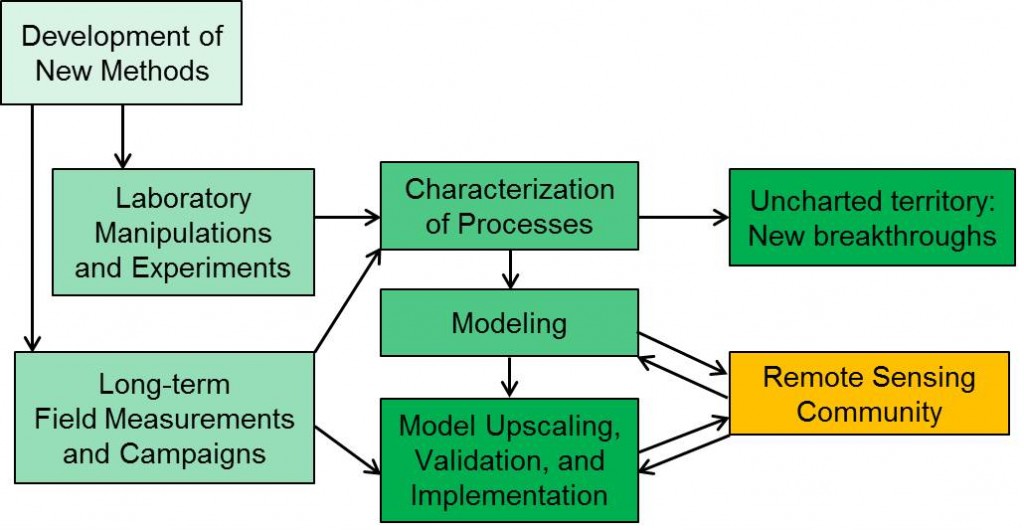Reflectance and fluorescence methods have been used for decades in plant biology, for example to elucidate the structure and functioning of photosynthesis (e.g. Figure 1). The same methods are now being adopted by the remote sensing community in an attempt to track vegetation productivity and dynamics from towers, aircrafts and satellites. Despite that these developments have the potential to breakthrough new science and business opportunities, the approach is still limited by the lack of mechanistic understanding. The processes that underlie the relationship between optical data and plant function in the spatiotemporal context of remote sensing applications, remain unclear. These processes expand into the seasonal scale, across species and environmental gradients.
Figure 1. Chlorophyll is the pigment that colours leaves green. If chlorophyll is extracted from leaves and exposed to light we observe a startling phenomenon; the previously green extract turns to a ruby red colour! It’s not sorcery, it’s chlorophyll fluorescence (A). The yield of chlorophyll-a fluorescence in the extract is high and constant. In contrast, when chlorophyll molecules are connected to a photosynthetic machinery the yield is very small and dynamic. Small, because photosynthesis uses most of the absorbed energy. Dynamic, because photosynthesis and protective mechanisms are constantly responding to the environment. These dynamics can be measured in the field (B), giving information on the diurnal and seasonal variation in photosynthetic parameters such as the operating quantum yield of photosystem II (C). (Porcar-Castell 2011, Physiologia Plantarum 143:139-153)
OUR VISION: Photosynthesis has a critical role in Plant Science research. Not only because it controls plant primary productivity but because it mediates the “optical expression” of multiple plant physiological processes, turning visible the invisible, and measurable at any scale. With the current technological advances in the fields of spectroscopy, aeronautics, and microcomputers it is just a question of time that we will be able to measure anything anywhere, but we will still need to interpret the data and add value to it. This is our research niche.
OUR MISSION: Our long-term mission is to generate new knowledge and methodologies that allow us to link optical, biochemical and functional traits of vegetation. We believe that by doing so we will be able to go beyond the walls of a laboratory or the limits of an experimental plot and make it possible to study plant ecophysiology at unprecedented scales.
The main strength of our Lab is our capacity to cope with multiple spatiotemporal scales and our holistic and multidisciplinary approach. We encompass continuous long-term measurements in the field, with intensive measuring campaigns and laboratory manipulation experiments. Through our network of collaborators we are able to combine scales than span many orders of magnitude: from nanosecond-scale fluorescence lifetime measurements to satellite measurements, linking the molecular and global scales. We apply a bottom-up approach where we generate mechanistic understanding at the small scale and apply it to larger scales. To this end, we adapt, develop, and implement process-based and radiative transfer models to assimilate optical data at multiple scales (Figure 2).
Figure 2. Research Flux in the Optics of Photosynthesis Laboratory (green), and interaction with Remote Sensing community.


